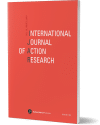A participatory approach to peacebuilding evaluation in Seke district, Zimbabwe
Norman Chivasa
IJAR – International Journal of Action Research, Issue 3-2019, pp. 198-216
Abstract
Mainstream monitoring and evaluation (M&E) of peacebuilding tends to be mainly practitioneroriented, while under-reporting initiatives by ordinary people who develop an interest to learn from their own practice. This study aims to fill this gap, by reporting the evaluation of a self-initiated peace committee by ordinary people in the Seke district, Zimbabwe. The study revealed that local communities currently possess the propensity to work as a collective with shared experiences and perceptions, and the linkages between these attributes and participatory peacebuilding initiatives are natural. Furthermore, it emerged that action research can be a useful methodology, with the potential to create space for ordinary people to participate in the design, implementation, M & E of peace initiatives in their villages. Although this study examined the role of self-initiative monitoring and evaluation destined to become an alternative to technocratic M & E, it acknowledges the value of top-down M & E of peacebuilding and does not seek to replace them, rather, to bring bottom-up M & E practices into the mainstream M &E of peacebuilding using local initiatives as a vehicle to create a greater impact on peacebuilding interventions.
Key words: action research, evaluation, participatory peacebuilding, Zimbabwe
Un enfoque participativo para la evaluación de la construcción de la paz en el distrito de Seke, Zimbabue
Resumen
El monitoreo y la evaluación mainstream (M&E) de la construcción de la paz tienden a estar principalmente orientados a los profesionales, mientras que no se reportan las iniciativas de las personas comunes que presentan un interés por aprender de sus propias prácticas. Este estudio tiene como objetivo llenar este vacío al informar la evaluación de un comité de paz auto-iniciado por personas comunes en el distrito de Seke, Zimbabue. El estudio reveló que las comunidades locales poseen actualmente la propensión a trabajar como un colectivo con experiencias y percepciones compartidas, y los vínculos entre estos atributos y las iniciativas participativas de construcción de la paz son naturales. Además, surgió que la investigación- acción puede ser una metodología útil con el potencial de crear un espacio para que la gente común participe en el diseño, implementación, monitoreo y evaluación de iniciativas de paz en sus aldeas. Aunque este estudio examinó el papel del monitoreo y la evaluación por iniciativa propia destinados a convertirse en una alternativa al monitoreo y evaluación tecnocráticos, reconoce el valor de M&E de arriba hacia abajo para la construcción de la paz y no busca reemplazarlos, más bien, busca llevar las prácticas de M&E de abajo hacia arriba dentro del M&E mainstream de la construcción de la paz utilizando iniciativas locales como vehículo para crear un mayor impacto sobre intervenciones de construcción de la paz.
Palabras clave: investigación-acción, evaluación, construcción de la paz participativa, Zinbabue
Introduction
Research that emphasises the participatory nature of action research (AR) is increasingly gathering momentum within mainstream peacebuilding discourses. This follows a surge of interest to employ AR as a strategy to address peace and development challenges in postconflict societies in the 1990s by international donor communities, peace researchers and practitioners. A case in point was the War-torn Societies project (WSP) which tested the potential of AR in rebuilding the socio-economic, political and cultural challenges in four different countries namely; Eritrea, Mozambique, Guatemala and Northeast Somalia between 1994 and 1998. In these conflict-ravaged societies, the participatory nature of AR was employed to ensure local ownership between different actors involved in rebuilding socio-economic and political institutions (Fagen 1995; Farah et al. 1998; Johannsen 2001; Stiefel 2001). As Johannsen (2001, p. 2) asserts, AR was implemented “in order to render academic research more applicable to the needs of those being studied, and encourage them to actively participate in the research design, methodology and projected outcome.” As a scientific method, AR has the potential to assist research participants to better understand problems affecting them and generate solutions to those problems. By implication, scientific methods are seen as a reliable guide towards informed and effective action (Lisa 1984). Consequently, academics and practitioners consider AR as a strategy that brings together different actors involved in addressing peace and development challenges (Johannsen 2001). It is also considered a useful strategy to address immediate and practical problems with a view to contribute to theory and knowledge and to improve practice (Lisa 1984).
The study is framed within discourses on monitoring and evaluation (M&E) of peacebuilding initiatives and participatory M&E practices (impact assessment) (Koltzow 2013). M&E of peacebuilding initiatives continues to suffer from a myriad of challenges resulting from contentions over evidence on the impact of peace interventions. To be specific, the greatest challenge is that peace is a non-linear process, and it defies replicable and verifiable measurements because of its fluidity (Church 2008; Koltzow 2013; Menkhaus 2004). However, while M & E discourses are focusing on elitist/technocratic (standardised) evaluation models of measuring peace (Paffenholz 2011; (OECD) Organisation for Economic Co-operation and Development 2012; Andersen & Kennedy-Chouane 2014), the current study focused on bottom-up evaluation by ordinary people who developed an interest in evaluating their own peace initiatives. In M & E of peacebuilding, what has not received academic attention is the involvement of ordinary people who developed an interest to use scientific methods to evaluate their own initiatives. The aim of this study was to address the identified gap, by reporting on evaluation activities conducted by ordinary people through the AR framework to determine the outcome of a peace committee in ward 8 of Seke district, Zimbabwe.
In addition to the above, the article referred to 2014 collaboration and partnerships between 14 ordinary people and a researcher in ward 8 of Seke district, that led to the creation of a ward peace committee (WPC) by using the four step participatory process of AR namely, problem identification, planning, taking action and evaluation (Coghlan & Brannick 2014). The article reports the subsequent self-evaluation process by WPC with a goal to contribute to M&E on peacebuilding discourses, which do not make provision for evaluation of initiatives by ordinary people who developed an interest to learn from their own practice through the use of scientific methods. The self-evaluation activities by members of the WPC illuminated the writing of this article.
Background and study locale
Seke is one of nine districts in Mashonaland East province, Zimbabwe. It comprises 21 wards consisting of 8 communal and 13 commercial areas. Crop production is the primary means of livelihood in Seke district. As at 2015, the average poverty prevalence in all 21 wards stood at 56% (United Nations Children’s Fund (UNICEF 2015).
Ward 8 is a communal area, which largely relies on subsistence crops and livestock farming. Crops include maize, groundnuts, sweet potatoes, small grains (such as millet), cow peas and beans, while livestock includes traditional chickens, goats and cattle. Proximity to Harare and Chitungwiza agricultural markets has propelled market gardening involving crops such as tomatoes, onions and other vegetables grown as cash crops providing livelihoods for households. To supplement their livelihoods, some sections of rural people in ward 8 have adopted village savings and loan associations (VSLA) scheme (Chivasa 2015).
A previous study by Chivasa (2015) outlined some of the conflict issues bedeviling residents in ward 8 as the impetus behind the creation of the WPC. The conflict issues singled out in Chivasa’s report include among others, hunger and food insecurity at households level, unavailability of finances to pay school fees, rape cases involving girl children, domestic violence, stock theft, robber, fist fighting at beer parties and disputes over land boundaries. Accordingly, peacebuilding is understood in ward 8 of Seke district as a process involving the building of relationships, trust between individuals and groups, prevention of small scale violence (such as fist fighting, intimate partner violence), prevention of conflict and its resolution and coming up with modalities to improve livelihoods of individuals and groups at household level (Chivasa 2015). It is against this background that a peace committee was envisaged as a peacebuilding mechanism, that provided the inhabitants with a platform to take responsibility for their own peace and development aspirations.
Literature Review
In peacebuilding discourses, a new surge of participatory and community-driven peacebuilding endeavors known as participatory peacebuilding has emerged (Nascimento, Keeler & Jacobs 2004). The emergence of participatory peacebuilding initiatives is linked to local ownership discourses in development theory, which emerged against the background of domination by developed countries over the developing world (Shinoda 2008). Local ownership discourses took prominence in the early 1990s among development aid agencies (Saxby 2003). In development theory and practice, local ownership has always been understood as involving four different dynamics. Firstly, ordinary people taking responsibility for their own development aspirations. Second, recipient ordinary people owning and implementing development initiatives. Third, ordinary people participating in decision making processes and fourth, ordinary people having the right to self-determination (Lavergne 2003; Saxby 2003). Viewed from a peacebuilding perspective, the non-participation of ordinary people was perceived to be one of the recipes for failed peacebuilding. In the above context, during 2001, the concept of local ownership was integrated into peacebuilding theory by the United Nations Security Council (UNSC) of February 2001 (para. 10-12). The UNSC perceived local ownership to be one of the preconditions for sustainable peace (cited in Bojicic-Dzelilovic & Martin 2016; Demir 2017). This integration of local ownership culminated in local ownership in peacebuilding. Since then, the concept of local ownership in peacebuilding has been subjected to scholarly evaluation and assessments. Richmond (2009) understood local ownership in peacebuilding as ‘everyday forms of peace’ arguing that peace is not found in institutions but in everyday interactions, informal relationships of individuals and groups. This is so because peace is a local construct that represents the needs, preferences and aspirations of people within a local context (Richmond 2014). MacGinty (2013) contends that local forms of peace represent the on-ground conditions and practices by which people sustain and promote peace. Peace is part of everyday life of people, and for that reason it is constructed in the vernacular (Funk & Said 2010). Ojendaal, Leornadso & Lundquist (2017) view local ownership in peacebuilding as the local turn. In the local turn discourses on peacebuilding, emphasis has been placed on creating space for local people to participate and arrive at independent decisions to meet their peace aspirations. The local turn clarifies the post-liberal peacebuilding, which emphasises participation of ordinary people in peacebuilding processes. Consequently, discourses on bottom-up peacebuilding and post-liberal peacebuilding argue in favour of the prominent role of participatory peacebuilding. Participatory peacebuilding is helpfully explained by Nascimento, Keeler & Jacobs (2004, p. 6):
First of all, local population is involved. Consequently, the peacebuilding process will become their process, in which they are closely involved. They will determine to a great extent how the process will look. It is not someone else’s plan imposed on them. Participation also means that it [peacebuilding process] is drawn from local conflict handling potential [home grown]. This approach generally enjoys a high level of legitimacy and credibility. No methods, concepts or models for resolving conflict or building peace are imposed from outside. Rather they are based on the local understanding of conflict and resolving and fit their ways of being and doing. All this will create a feeling among people in the conflict setting that they own the peacebuilding process.
As the above excerpt suggests, participatory peacebuilding involves local agency, which embraces both peacebuilding from below and within. Participatory peacebuilding is the focus of this study.
* * *
 Would you like to continue reading? This article was published in Issue 3-2019 of IJAR – International Journal of Action Research.
Would you like to continue reading? This article was published in Issue 3-2019 of IJAR – International Journal of Action Research.
© Unsplash 2022 / image: Trust “Tru” Katsande

